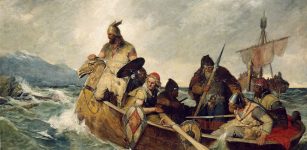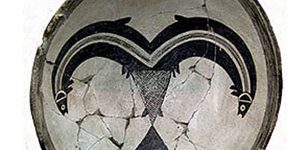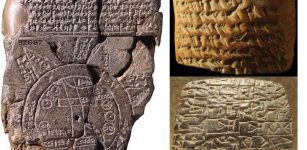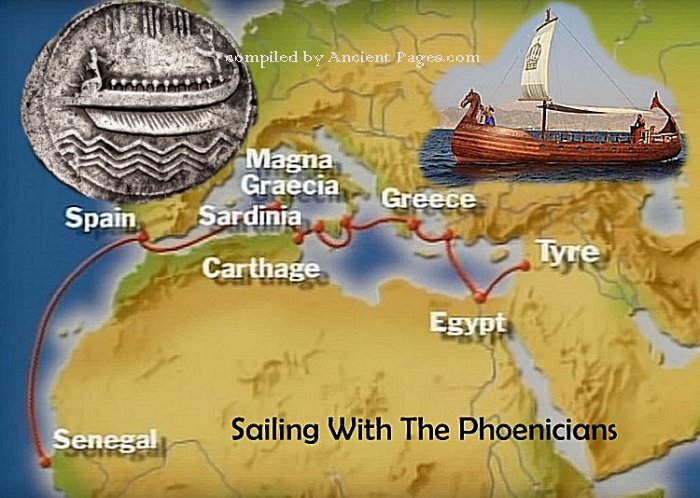Phoenicians: Powerful Traders And Their Remarkable Seafaring Achievements
A. Sutherland - AncientPages.com - The Phoenicians remain one of the most enigmatic ancient civilizations. Our knowledge of these ancient people is based on scholars' speculations and educated guesses.
Although many Greek, Roman, and Egyptian writers mention the Phoenicians in trade records and military battles, only a few records were left by the original Phoenicians themselves, leaving modern scholars to fill in the blanks through these educated guesses and material culture.
With the material we possess, we can never obtain the whole picture of this civilization.
Today, their culture is associated with long-distance seafaring, trade and colonization, exploration, and language. However, in ancient times, the Phoenicians still needed to be protected from ground-based attacks. Therefore, over time, they developed a strong military and well-secured city fortifications that protected individual settlements.
Interestingly, when they first appear in western records of the 8th and 7th century BC, the Phoenicians are described as those who possess many colonies, wide trade networks reaching as far as the Black Sea, from which they challenged the Greeks and later the Romans. Their ships were seen in harbors on the Atlantic coast of Africa.
According to Biblical accounts, already at an earlier period, the tenth century BC, their artisans, and artists were matchless, and they were sponsoring, together with King Solomon, ambitious naval accomplishments.
However, scholars continue to question when the Phoenicians became powerful, where they came from, and how they came to be such excellent navigators and successful merchants who managed to colonize much of the Mediterranean region.
The Canaanites' Origin Of The Phoenicians
The Phoenicians originated from the Canaanites' ancient culture in the region during the earlier Bronze Age (3000-1200 BC. It was concentrated along the coast of Lebanon and included some coastal areas of modern Syria and Galilee, reaching as far north as Arwad and as far south as Acre.
Phoenicia was not a single centrally administered state; it was more akin to ancient Greece, with its city-states, and one of the wealthiest and most developed state organisms of antiquity. Because the Phoenicians were spread out, they possessed numerous city-states that formed essential parts of their maritime trade networks. Archaeologists have discovered around eighty separate city-states scattered through a diverse region.
The most significant city-states were in the region of Lebanon, where the Phoenicians originated. Other settlements, also of great importance could be found in Algeria, Libya, Malta, Cyprus, Italy, Spain, Tunisia, Turkey, and Morocco.
The Phoenician Civilization With Many Contradictions
"The Phoenicians were a clever race, who prospered in war and peace," wrote around AD 43, the earliest Roman geographer, Pomponius Mela. Mela described the Phoenicians as the ones who "excelled in writing and literature, and other arts, in seamanship, and in ruling an empire."
He also wrote they were great writers, yet they left almost no documents.
Siege of Tyre. Drawing of the end of the 17th century. Public Domain
They may have been excellent sailors and naval commanders, yet they built no territorial empire. They were stellar artists, yet their work contains few original elements. They may have been creative builders, yet their monuments crumbled. And the Phoenicians were a single civilization, yet they were split into city-states.
However, not all writers praised the Phoenicians. The ancient view of this civilization varied.
Some Interesting Questions About The Phoenicians
Some interesting and unanswered though valid questions are: How could a civilization exist with so many contradictions? How can modern historians utilize evidence that no longer seems to exist to uncover the truth about these people? And why did their civilization finally crumble?
As Canaanites, they had remarkable seafaring achievements. The Phoenicians were great maritime people, known for their mighty ships and a great experience as sea traders, traveling across the Mediterranean Sea and reaching as far north as Britain, Egypt, and Senegal.
The basis of their prosperity was long-distance trade that at that time was greatly influenced by the favorable location of colonies and cities on the main trade lines.
The Phoenicians' unique, perfectly organized commercial network flourished across the Mediterranean Sea in the 5th century BC. The ships in all sizes and all possible uses in different areas were included in the Phoenician trade network and reached very far.
A phoenician ship leaves the city of Carthage. Credit: Massimo Todaro - Adobe Stock
Their man-powered sailing vessels are mentioned in very early records confirming their arrival in Egypt from Byblos loaded with cedarwood in ca. 3000 BC. They were also used during the time of Carthage's defeat by the Roman forces in 146 BC.
Timber, spices, amber, gems, copper, and slaves had to be transported systematically from one country to another despite great distances.
The export goods were agricultural fruits and handicrafts, luxury metal products, the so-called Phoenician purple, greatly prized in antiquity and used as a fabric dye as early as 1200 BCE by the Phoenicians, and later continued by the Greeks and Roman. Above all, however, Lebanese cedars represented a precious and profitable material.
In exchange, Phoenician merchants imported gold, silver, tin, lead, copper, and slaves, which were traded on a large scale.
Phoenicians' Key Achievement - Alphabet And Writing
No doubt, the Phoenicians' outstanding achievement was the development of writing, with letters that were later taken over and expanded by the Greeks forming the Latin alphabet.
This alphabet originates from the Proto-Canaanite alphabet, during the 15th century BC, and earlier, the Phoenicians wrote with a cuneiform script. The earliest known inscriptions in the Phoenician alphabet come from Byblos and date back to 1000 BC. Many alphabetic writing systems like Greek, Etruscan, Latin, Arabic, and Hebrew and India and East Asia's scripts can be traced back to the Phoenician alphabet.
Phoenician Cities Under Foreign Rule
For most of their history, the Phoenicians remained under foreign rule or influence of political powers like Egypt, Assyria, Babylon, Persia, Macedonia, and Rome.
Gradually, the Phoenicia began to decline, and finally, Alexander the Great conquered Tyre and other Phoenician cities in 332 BC.
After him, the Phoenicians came under Ptolemy's Egypt's rule, and later the Syrian Seleucids. In 64 BC, the Phoenician cities were under the control of the Romans.
Written by – A. Sutherland - AncientPages.com Senior Staff Writer
Copyright © AncientPages.com All rights reserved. This material may not be published, broadcast, rewritten or redistributed in whole or part without the express written permission of AncientPages.com
Expand for referencesReferences:
Sabatino Moscati, The Phoenicians
Harden, D. The Phoenicians.
De Lafayette, Phoenicia, Ur, and Carthage: Artifacts, Inscriptions, Slabs, Sites
More From Ancient Pages
-
 Evolution Might Stop Humans From Solving Climate Change – Researchers Say
Evolution | Jan 3, 2024
Evolution Might Stop Humans From Solving Climate Change – Researchers Say
Evolution | Jan 3, 2024 -
 Pants And Boots Were Forbidden In Ancient Rome – Trousers Were A Symbol Of Barbarism To Ancient Romans
Ancient History Facts | Dec 6, 2017
Pants And Boots Were Forbidden In Ancient Rome – Trousers Were A Symbol Of Barbarism To Ancient Romans
Ancient History Facts | Dec 6, 2017 -
 Ancient Entrance Gate Found In Biblical City Of Bethsaida (Zer) Where Jesus Performed His Deeds Of Power
Archaeology | Jul 11, 2018
Ancient Entrance Gate Found In Biblical City Of Bethsaida (Zer) Where Jesus Performed His Deeds Of Power
Archaeology | Jul 11, 2018 -
 Owain Glyndwr: Famous Medieval Welsh Warrior Prince And Symbol Of Independence
Featured Stories | Jun 20, 2018
Owain Glyndwr: Famous Medieval Welsh Warrior Prince And Symbol Of Independence
Featured Stories | Jun 20, 2018 -
 Evidence Scots And Irish Settled Iceland A Century Before The Vikings?
Featured Stories | Jan 7, 2023
Evidence Scots And Irish Settled Iceland A Century Before The Vikings?
Featured Stories | Jan 7, 2023 -
 7,000-Year-Old Underwater Road Discovered In Adriatic Sea Off Korcula Island
Archaeology | May 11, 2023
7,000-Year-Old Underwater Road Discovered In Adriatic Sea Off Korcula Island
Archaeology | May 11, 2023 -
 What Happened To Mimbres People – Recently Examined Puzzle Gives Some Clues
Archaeology | Dec 29, 2021
What Happened To Mimbres People – Recently Examined Puzzle Gives Some Clues
Archaeology | Dec 29, 2021 -
 The Mysterious Books Of Prophecies Of The Knights Templar – Where Are They Hidden?
Featured Stories | Mar 26, 2022
The Mysterious Books Of Prophecies Of The Knights Templar – Where Are They Hidden?
Featured Stories | Mar 26, 2022 -
 A 5,000-Year-Old Anatolian Sword Identified In Armenian Monastery In Venice
Artifacts | Feb 28, 2020
A 5,000-Year-Old Anatolian Sword Identified In Armenian Monastery In Venice
Artifacts | Feb 28, 2020 -
 Andalusia Was First Inhabited By Neolithic People From The Southern Part Of The Iberian Peninsula 6,200 Years Ago
Archaeology | Feb 26, 2024
Andalusia Was First Inhabited By Neolithic People From The Southern Part Of The Iberian Peninsula 6,200 Years Ago
Archaeology | Feb 26, 2024 -
 On This Day In History: Battle of Champion Hill Was Crucial Action Of Grant’s Vicksburg Campaign – On May 16, 1863
News | May 16, 2016
On This Day In History: Battle of Champion Hill Was Crucial Action Of Grant’s Vicksburg Campaign – On May 16, 1863
News | May 16, 2016 -
 5 Myths About The Amazons – Ancient Female Warriors
Featured Stories | Jan 13, 2016
5 Myths About The Amazons – Ancient Female Warriors
Featured Stories | Jan 13, 2016 -
 Unusual Underwater Archaeological Discovery In California May Confirm Thousand-Year-Old Legend And Re-Write Ancient History
Featured Stories | Aug 15, 2024
Unusual Underwater Archaeological Discovery In California May Confirm Thousand-Year-Old Legend And Re-Write Ancient History
Featured Stories | Aug 15, 2024 -
 Land of Israel: A 5,000-Year-Old Settlement And A Pottery Kiln Unearthed Near Beit Shemesh At The Site Of Hurvat Husham
Archaeology | Oct 30, 2024
Land of Israel: A 5,000-Year-Old Settlement And A Pottery Kiln Unearthed Near Beit Shemesh At The Site Of Hurvat Husham
Archaeology | Oct 30, 2024 -
 Viking Law And Order Was Based On The Thing System
Ancient History Facts | Aug 21, 2023
Viking Law And Order Was Based On The Thing System
Ancient History Facts | Aug 21, 2023 -
 Ensisheim Meteorite Is The Oldest Meteorite With A Precise Date Of Impact
Ancient History Facts | Jun 29, 2018
Ensisheim Meteorite Is The Oldest Meteorite With A Precise Date Of Impact
Ancient History Facts | Jun 29, 2018 -
 Cuneiform Tablets: One Of The Earliest Systems Of Writing Invented By The Sumerians
Civilizations | May 8, 2017
Cuneiform Tablets: One Of The Earliest Systems Of Writing Invented By The Sumerians
Civilizations | May 8, 2017 -
 3,000-Year-Old Egyptian Artificial Wooden Toe In New Light
Archaeology | Jun 20, 2017
3,000-Year-Old Egyptian Artificial Wooden Toe In New Light
Archaeology | Jun 20, 2017 -
 4,000-Year-Old Stonehenge Of The Netherlands Reveals Its Secrets
Archaeology | Jun 22, 2023
4,000-Year-Old Stonehenge Of The Netherlands Reveals Its Secrets
Archaeology | Jun 22, 2023 -
 Rock Stars: How A Group Of Scientists In South Africa Rescued A Rare 500 Kg Chunk Of Human History
Featured Stories | Oct 20, 2022
Rock Stars: How A Group Of Scientists In South Africa Rescued A Rare 500 Kg Chunk Of Human History
Featured Stories | Oct 20, 2022



